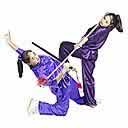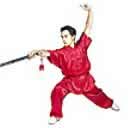|
Kung-fu, Wushu - Chinese Martial ArtsKung-fu, Wushu - Learn about the chinese martial arts - History, styles, philosophy...
Kung-fu, Wushu and the Chinese martial arts are all different words which refer pretty much to the same thing. The only exception is wushu which also refers to a modern day martial sport and competition. Therefore when using the words “Kung-fu” or “Chinese martial arts” we mean the same. Chinese martial arts are probably the most versatile of all martial arts. This is due to the length of time which they have been developing in China’s culture (more than 5000 years), the fact that the use of fire arms was not common amongst the public and military until late dates and the amount of people living in China (25% of the worlds population). Due to Chinese religion, philosophy and tradition the martial arts are rarely looked upon as only fight oriented. The Chinese have a holistic (everything is connected to everything) understanding of the world, which did not "skip" the arts aswell. A martial art must achieve goals aside from the fighting aspects. Self cultivation, for example, might sometimes be more important for a teacher than winning the fight thus bringing him to change essential parts of the martial art. These influences are very important to understand as sometimes techniques and tactics ( Read more about the Theory of a Martial Art) were abandoned and eventually forgotten because they didn’t fit to the philosophy or religion of the practitioner, even if from a pure fighting point of you they were correct. When practicing a martial art we must be aware of our goals, the goals of our art and how they came to develop. Furthermore learning the culture, history, roots and origins of our art, in some cases, can help us fully appreciate it. Kung-fu Wushu and Chinese martial arts -Terminology:Like explained in the beginning due to Chinese language many terminologies have been given to the same essential thing. Kung-fu or Gongfu - means a general ability and skill gained through minded repetition. (Unnecessarily a martial art one). Wushu – means “martial methods” and is also the word used to define the modern day wushu martial art or sport competition. Goushu or kuoshu – meaning the “arts of the nation” or “national methods” is and was a term encouraged to use by the Chinese government to nationalize the martial arts practice Brief HistoryOrigins (real proof) of Kung-fu can be traced back to 1000 B.C. They were used for every day life – hunting, self-defense, and for military training. These arts included empty hand fighting, weaponry techniques and training methods. Despite common belief Chinese martial arts were not invented at the Shaolin temple.It’s believed that the Yellow Emperor (2700 B.C.) was the first to introduce the martial arts to Chinese culture. It was the idea of Confucius (a famous Chinese scholar which had much influence on china’s culture – 500 B.C) to turn practicing martial arts into an everyday activity for the Chinese people and not only for soldiers and specific groups. Records and “how to” manuals for empty hand combat and wrestling had already been written dating back to 200 B.C – 10 C.E The earliest evidence of martial art combat in the Shaolin monastery dates back to around 600 A.C. It was developed in order that the monks will be able to defend themselves against bandits. During the Republican Period (1912-1949) the Chinese martial arts were made more accessible to the public, and martial artists were encouraged to teach their arts as means of promoting national pride. When the People’s Republic of China (1949) was founded after the Chinese civil war, many martial artists fled and migrated outside of the republic from fear of prosecution. This led to the international spreading of the different styles. During the years there have been many attempts to re-legitimize the martial arts in the Chinese Republic, starting with the formation of the “sport” of Wushu as something disassociated with the martial arts and connected with national pride in 1958. The Chinese government has since the 1970’s taken on itself the rebuilding, and re-documentation of the Chinese martial arts that were lost or forgotten. Now a days both Wushu and traditional Chinese martial arts are being promoted by the government. 
Chinese culture, philosophy and famous booksIt is very hard to try and generalize the Chinese culture so that one might try to understand the origins of its martial arts. However the cultural ground in which the martial arts we know today grew and developed upon are: • Buddhism and Zen Buddhism • Taoism / Daoism • Holistic thinking - every thing is connected to everything. • Chinese medicine – dating back to the “Yellow Emperor” and the I-Ching (book of changes) • Ancestral respect and sometimes worship – “Every thing in the past was better and wiser…” • Confucius, Lau Tzu, Sun Tsu.. Chinese martial arts are embedded in Chinese culture, and it is impossible to understand the development of one with out the other. Many books, poems, legends and thoughts have been written about the martial arts and the philosophies behind it, during the last 5 thousand years here are a few famous ones: • Tao Te Ching – Credited to Lau Tsu – A Taoist or Daoist monk living in the 5th century B.C. • Zhuangzi – A text about the training and psychology of the martial arts from a Taoist point of you – 4th century B.C. • The Art of War – Credited to Sun Tzu – A book that is still studied in military academies around the world, and which gives good tactical and strategy ideas. – 6th century B.C. • Ji Xiao Xin Shu – Credited to Qi Jiguang – Published descriptions of shaolin techniques Kung-fu stylesIt is very hard to classify and divide between the different kung-fu styles, and through the years there have been made many distinctions: • Shaolin, ermei or wudang – classifying them according to releligious origin. • Animal oriented – Due to Taoist philosophy imbedded in Chinese culture attempts to imitate animal fighting as a means to fight. • Internal(soft) and external(hard) styles – As a means to point out where the power originates from. • Northern or Southern styles – Geographical place of origin - Northern implementing more jumping and kicking, and southern implementing more hand work, and strong stance. • Philosophy Oriented – Martial arts which have been based on philosophical ideas. The classifications here are very general and are often argued and disagreed upon in the martial art world. Some of the Styles in Chinese martial arts still practiced today: Hun Gar, Lau Gar, Hsing I, I Chuan, Five animals, Ba Gua, Tai Chi, Drunken Boxing, Eagle Claw, Wing Chun, Monkey, Bak Mei Pai, Praying Mantis, Fujian White Crane, Crane, Long Fist, White Eye Brow… Among the weapons we can see practiced today are: • Nun-Chuks (also attributed to karate) • Double ended and regular spear • 2-sectional, 3-sectional, double short and normal staff. • Straight, broad, kwan, double, double straight and double hook sword/s. • Chained hammer. • Rope-dart • Daggers • Nine section whip • And more Entering the world of Kung-fuKung-fu/Chinese martial arts are very versatile. However the vast majority concentrates on striking techniques, some apply throwing, joint manipulation, submission holds and pressure points, and none apply ground fighting (considered to be degrading or “dog” fighting – though there was once an art developed for this purpose). Entering this world undoubtedly holds many interests and is backed up by years of tradition If you would like to learn more about the Chinese way of thinking one no doubtedly needs to read the wise book of the Tao te Ching. A great site to begin with is:
www.Taotechingme.com - A site where lovers of various translations of the Tao te Ching are welcome to comment on or submit their favorite chapters"
Return from Kung-fu and Chinese Martial Arts to Types of Martial Arts Return from Kung-fu to the Home Page |
